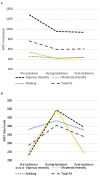Changes in Physical Activity Pre-, During and Post-lockdown COVID-19 Restrictions in New Zealand and the Explanatory Role of Daily Hassles
- PMID: 33716912
- PMCID: PMC7947353
- DOI: 10.3389/fpsyg.2021.642954
Changes in Physical Activity Pre-, During and Post-lockdown COVID-19 Restrictions in New Zealand and the Explanatory Role of Daily Hassles
Abstract
Covid-19 lockdown restrictions constitute a population-wide "life-change event" disrupting normal daily routines. It was proposed that as a result of these lockdown restrictions, physical activity levels would likely decline. However, it could also be argued that lifestyle disruption may result in the formation of increased physical activity habits. Using a longitudinal design, the purpose of this study was to investigate changes in physical activity of different intensities, across individuals who differed in activity levels prior to lockdown restrictions being imposed, and across three time periods: pre-, during- and post-lockdown. This study also examined the extent to which the experience of daily hassles explained any changes in physical activity. A convenience sample (N = 759) recruited through social media, provided data from an online survey administered during weeks 2-3 of a 5-week lockdown and 231 participants provided complete data again 6 weeks post-lockdown (72% female, M age = 43 years). Participants completed the International Physical Activity Questionnaire-Short Form and the Daily Hassles Scale. Results showed that vigorous and moderate intensity PA were significantly lower during- and post-lockdown compared to pre-lockdown in those individuals who had been highly active pre-lockdown. In contrast, for moderately active individuals pre-lockdown, vigorous and moderate intensity PA was significantly higher during-lockdown compared to pre-lockdown, and these increased levels of vigorous PA were maintained post-lockdown. Participants experienced daily hassles due to inner concerns, time pressures, family, and financial concerns to the same extent during- and post-lockdown. Those daily hassles had a small negative (Standardized β = -0.11; p < 0.05) predictive effect on post-lockdown PA. It appears that to understand the effect of COVID-19 restrictions on PA, the activity status of individuals pre-lockdown needs to be taken into account. The daily hassles appeared to play a role in post-lockdown PA behavior, but future research should investigate why these results occurred.
Keywords: COVID-19; behavior change; exercise; physical activity intensity; psychology; stress.
Copyright © 2021 Hargreaves, Lee, Jenkins, Calverley, Hodge and Houge Mackenzie.
Conflict of interest statement
The authors declare that the research was conducted in the absence of any commercial or financial relationships that could be construed as a potential conflict of interest.
Figures



Similar articles
-
Effects of the COVID-19 associated United Kingdom lockdown on physical activity in older adults at high risk of cardiovascular disease: a mixed methods perspective from the MedEx-UK multicenter trial.Front Public Health. 2024 May 9;12:1371453. doi: 10.3389/fpubh.2024.1371453. eCollection 2024. Front Public Health. 2024. PMID: 38784572 Free PMC article.
-
Physical Activity Behavior Before, During, and After COVID-19 Restrictions: Longitudinal Smartphone-Tracking Study of Adults in the United Kingdom.J Med Internet Res. 2021 Feb 3;23(2):e23701. doi: 10.2196/23701. J Med Internet Res. 2021. PMID: 33347421 Free PMC article.
-
Physical Activity Behavior During and After COVID-19 Stay-at-Home Orders-A Longitudinal Study in the Austrian, German, and Italian Alps.Front Public Health. 2022 May 31;10:901763. doi: 10.3389/fpubh.2022.901763. eCollection 2022. Front Public Health. 2022. PMID: 35712287 Free PMC article.
-
Evolution of changes in physical activity over lockdown time: Physical activity datasets of four independent adult sample groups corresponding to each of the last four of the six COVID-19 lockdown weeks in Greece.Data Brief. 2020 Oct;32:106301. doi: 10.1016/j.dib.2020.106301. Epub 2020 Sep 11. Data Brief. 2020. PMID: 32934972 Free PMC article.
-
Physical activity and sitting time prior to and during COVID-19 lockdown in Austrian high-school students.AIMS Public Health. 2021 Jul 26;8(3):531-540. doi: 10.3934/publichealth.2021043. eCollection 2021. AIMS Public Health. 2021. PMID: 34395703 Free PMC article.
Cited by
-
Mental and physical health and well-being of canadian employees who were working from home during the COVID-19 pandemic.BMC Public Health. 2022 Oct 31;22(1):1987. doi: 10.1186/s12889-022-14349-5. BMC Public Health. 2022. PMID: 36316683 Free PMC article.
-
COVID-19 triggered a physically active lifestyle of people with cardiovascular diseases: Results of a small Austrian qualitative study.Front Public Health. 2022 Aug 12;10:947250. doi: 10.3389/fpubh.2022.947250. eCollection 2022. Front Public Health. 2022. PMID: 36033783 Free PMC article.
-
The Impact of COVID-19 on Maintaining Physical Activity and Its Associated Factors among Medical Students.Int J Environ Res Public Health. 2022 Nov 26;19(23):15752. doi: 10.3390/ijerph192315752. Int J Environ Res Public Health. 2022. PMID: 36497827 Free PMC article.
-
A prospective study of the impact of COVID-19-related restrictions on activities and mobility upon physical activity, travel behaviour and attitudes.J Transp Health. 2023 Jul;31:101624. doi: 10.1016/j.jth.2023.101624. Epub 2023 May 19. J Transp Health. 2023. PMID: 37228262 Free PMC article.
-
Stable physical activity patterns predominate in a longitudinal study of physical activity among young adults in Canada from before to during the COVID-19 pandemic.Prev Med Rep. 2022 Mar 29;27:101782. doi: 10.1016/j.pmedr.2022.101782. eCollection 2022 Jun. Prev Med Rep. 2022. PMID: 35392180 Free PMC article.
References
-
- Baltar F., Brunet I. (2012). Social research 2.0: virtual snowball sampling method using facebook. Internet Res. 22, 57–74. 10.1108/10662241211199960 - DOI
LinkOut - more resources
Full Text Sources
Other Literature Sources

